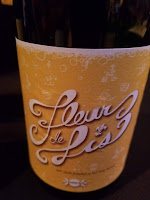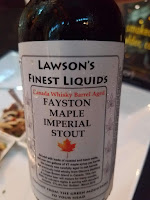 Toronto, home of the Maple Leafs and the Hockey Hall of Fame, the Raptors, the Blue Jays, and just as important, a vibrant craft beer environment. theCompass Craft Beverage Finder displays 45 establishments within Toronto so we anticipated a successful BlueJays-Nats series regardless of the scores. Our first stop was to a chain brewpub we had previously visited in Montreal, The 3 Brewers Yonge. This brewpub provides a core set of five beers with the White and IPA our preferred choices. However, each location also brews a seasonal and brewer's select beer with the former being a rather interesting Milkshake IPA and the second a delicious beer on cask which the brewer tapped for our benefit. Sadly, no one remembers the style or name.
Toronto, home of the Maple Leafs and the Hockey Hall of Fame, the Raptors, the Blue Jays, and just as important, a vibrant craft beer environment. theCompass Craft Beverage Finder displays 45 establishments within Toronto so we anticipated a successful BlueJays-Nats series regardless of the scores. Our first stop was to a chain brewpub we had previously visited in Montreal, The 3 Brewers Yonge. This brewpub provides a core set of five beers with the White and IPA our preferred choices. However, each location also brews a seasonal and brewer's select beer with the former being a rather interesting Milkshake IPA and the second a delicious beer on cask which the brewer tapped for our benefit. Sadly, no one remembers the style or name. On the way to the Rogers Centre we detoured to Mascot Brewery as it's one of the closet brewery to the stadium (Steam Whistle Brewing gets those honors). Sadly Mascot will be relocating soon as rich Hollywood types are redeveloping this trendy section. But for now their rooftop beer garden is a main attraction and on a pleasant evening their Mascot Pilsener is excellent. Hopefully the new location will also contain a kitchen as their food menu looks equally appealing.
On the way to the Rogers Centre we detoured to Mascot Brewery as it's one of the closet brewery to the stadium (Steam Whistle Brewing gets those honors). Sadly Mascot will be relocating soon as rich Hollywood types are redeveloping this trendy section. But for now their rooftop beer garden is a main attraction and on a pleasant evening their Mascot Pilsener is excellent. Hopefully the new location will also contain a kitchen as their food menu looks equally appealing.
Before our trip several of us had received heads up regarding Bellwoods Brewery, so Sunday morning we ventured straight to this establishment. And top to bottom, their entire portfolio was impressive -- particularly their IPAs. Starting with the unique Lupulin powdered Runes Citra & Simcoe IPA to the two juicy and delicious Imperial IPAs WitchShark and Goblin Sauce to the Neapolitan Milkshark - conditioned with vanilla, coca nibs and strawberries. Talking about a breakfast or dessert beer. Toned down a bit, their Jutsu is a solid and balanced Pale Ale and their dry-hopped Paper Tiger Pilsner is refreshing. Finally, the dry-hopped sours Jelly King and Raspberry Jelly King nailed my sour palate. Be warned, we were tempted to skip the game, the beers were that good....
If you do make it out of Bells and get to the Rogers Centre, Mill Street Brewery has a stand behind our seats at Gates 5 & 6. This Toronto brewery operates several brewpubs throughout Canada in addition to their Toronto brewery. During both night's games our group stuck to the Original Organic Lager and the Hopped & Confused Session Ale. The Lager was the first beer brewed by Mill Street back in 2002 and is an interesting take of a German Lager using New Zealand grown Pacific Gem and Wakatu hops. The Hopped & Confused weighs in at a mere 4.7% abv but packs loads of fruit and citrus flavors. Two ballpark beers.

The aforementioned Steam Whistle Brewing's Pilsner is also widely available at the ballpark and surrounding bars. In fact, this pilsner is the brewery's singular focus and adheres to the Bavarian Purity Act of 1516 by using only pure spring water, malted barley, hops, and yeast. The spring water is from Caldon, Ontario; the barley is Golden Two Row from Saskatchewan; the hops both German and Czech; and finally, the bottom fermenting lager yeast is sourced from Hungary. That's an interesting combination of locations. But one location we love is the Toronto craft beer scene. Cheers.











